Ian Davenport

Title: “Colorfall: Cobalt, Vermillion, Cobalt”
Year: 2012
Gallery: Paul Kasmin Gallery
Exhibition: Colorfall
Materials: acrylic on stainless steel, mounted on aluminum panel
Method of construction and dimensions: freehand sketching
Conceptual information: Davenport tries to articulate the beauty of simplicity and explore the nature-vs.-nurture conflict. In an attempt to identify the place of a human being in the universe, Davenport creates a unique “cavalcade of hues.”3
Critique: “Colorfall: Cobalt, Vermillion, Cobalt” is emblematic of the entire collection, as it incorporates the greatest variety of colour and render the largest range of emotions.4
Subjective response: Reminding of a waterfall, the artwork introduces the audience to a world of the surreal. The mixture of colours creates the environment for developing a synaesthesia and literally hearing the colours create a unique melody.

Title: “Staggered Lines: Flanger”
Year: 2013
Gallery: Paul Kasmin Gallery
Exhibition: Colorfall
Materials: acrylic paint on stainless steel, mounted on aluminum panel
Method of construction and dimensions: freehand sketching
Conceptual information: Davenport aims at capturing the magic of the ordinary by creating the art of “drip” – “something from the everyday.”5 The legacy of Duchamp can be traced easily in the artist’s creations. The alterations in the colour are used as the key “messenger of meaning.”6
Critique: The upward progression of the lines in “Staggered Lines: Flanger” sets a contrast to the rest of the artworks. It disrupts the pattern set by the artist and creates a menacing feeing.7
Subjective response: The upward progression is a natural response to the rest of the collection items. It represents the positive and active element of the human nature as opposed to the calm and composed downward streaks in the other artworks.
Jason Martin

Title: “Bracari”
Year: 2012
Gallery: Lisson Gallery
Exhibition: Infinitive
Materials: Pigment/mixed media on aluminium
Method of construction and dimensions: freehand drawing
Conceptual information: Jason Martin tries to show the materiality and the sculptural flexibility of paint in the most evident manner. It could be argued that the artist engages in the process of meta-creativity, since the artworks produced are not supposed to represent a specific concept or an idea – instead, the works explore the possibilities that paint as a tool offers to an artist. Putting a very strong emphasis on the transformative nature of the specified means of rendering ideas and emotions, Martin touches upon the concepts of alchemy in his analysis of the sculptural presence of paint and metal.
Critique: The artworks created by Jason Martin arguably owe their popularity solely to the oscillation between art and sculpture. The seeming incompatibility of the material that the artist works with, therefore, is often viewed as a rather cheap ploy for attention and, therefore, dismissed as lacking in substance. Nevertheless, Martin’s artworks should be considered an attempt to stretch the concept of expressivity and test the idea of using art tools as self-contained medium.9
Subjective response: Martin’s artworks in general and “Bracari” in particular create a truly surreal impression. They prevent the viewer from being distracted by the multi-layer context of the painting and wander into the area of the subconscious, setting their imagination free. A closer look at “Bracari” will stir a wide range of emotions, from soothing feeling of comfort and calm to the uneasy feeling of an oncoming storm. Emotionally fuelled and semantically freed, the painting is truly worth looking closer at.
Cecily Brown

Title: “The Fugitive Kind”
Year: 2000
Gallery: Saatchi Gallery
Exhibition: The Triumph of Painting
Materials: Oil on linen
Method of construction and dimensions: three-dimension painting
Conceptual information: One of the few artists, whose stylistic choices incorporate the legacy of Goya and Willem de Kooning, Cecily Brown has managed to blend the concepts of figuration and abstraction into a fascinating tool, which she uses to create her incredible artworks. Defined as animated brushwork, her style is both subtle and provocative, which makes Cecile Brown one of the most controversial artists of the century.
Critique: Focusing primarily on the subject of gender and sexuality, the artist has evolved from reimagining the rococo style to blending it with abstraction and the impressionist techniques.10 Cecily uses the ability of paint to recapitalise the physical sensation in order to render the concept of spontaneity and the illusion of motion. In addition, Brown incorporates some of the key social issues in her artworks, introducing the audience to her vision of the problem and, therefore, prompting a solution in the viewer.
Subjective response: Cecily Brown manages to trick the audience into getting enthralled with her artworks like any other artist. Even though she taps on a range of controversial social issues, she still expresses her opinion in an honest way, which helps establish a dialogue with the audience and, therefore, get the message across in as an efficient and expeditious manner as possible. Moreover, once the numerous symbolic elements lend their way to the general concept behind the artwork, one realises how complex Brown’s paintings are. Brown tries to embrace every single concept related to the issue raised in her art, which makes the latter anything but homogenous.
Jacqueline Humphries

Title: Mary/Mary
Year: 2004–2005
Gallery: Artnet
Exhibition: Greene Naftali
Materials: Oil on linen
Method of construction and dimensions: three-dimension painting
Conceptual information: The concept of “non-painting”11, which Humphries uses in her art, is obviously the legacy of such artists as Robert Motherwell and Phillip Guston12; nevertheless, Humphries has blended these influences into a fantastic mould, adding her own ingenuity to it. The resulting mixture has literally stirred the world of art, triggering a variety of critical responses, from delighted to indignant ones.
Critique: Despite the obvious uniqueness of her work, Humphries is often underrated as an artist due to the social and ethical context underlying her works. While she manages to drop some of the innuendoes in a rather subtle manner, most of them are quire on-the-nose, which ticks some of the most refined audience off13. The coalescence of images into an original shape, which Humphrey’s works are so famous for, is an impressive foot forward in revisiting the aesthetics of Expressionism in popular art.
Subjective response: Even though, personally, Jacqueline Humphries one of the most inspirational and fascinating artists of the century for me, I consider this particular artwork, i.e., Mary/Mary, legitimately scary. It would be silly to assume that the colour cast, i.e., the choice of a blood-like red hue, is the key reason for the viewer to experience a negative emotion. Therefore, it is not the choice of the palette that rubs me the wrong way, but the semantics of the medium chosen by the artist. Nevertheless, the specified piece of art sends an admittedly powerful message, which makes it one of the greatest art pieces of the decade.
Frank Auerbach

Title: “Portrait of Leon Kossoff”
Year: 1951
Gallery: Tate
Exhibition: Lent from a private collection
Materials: Oil paint on canvas
Method of construction and dimensions:
Conceptual information: Auerbach owes much of his expressionist style to David Bomberg, his teacher and the artist, whom Auerbach was obviously making an example of. Weirdly enough, at the very beginning of his career, Auerbach was criticised for an unreasonably thick application of paint, the approach, which would later on become his trademark stylistic feature. Despite the abundance of expressionist elements in his style, Auerbach cannot be deemed an Expressionist artist; instead, his artworks should be viewed through the lens of Figurativism.15
Critique: With all due respect to the innovativeness of Auerbach’s approach, one must admit that he restricts the themes of his art to what Burke defined as “standoffishness.”16 Devoting a range of his pictures to depicting Camden town, Auerbach, therefore, sets boundaries for his creativity, locking himself in the urban and suburban area. As a result, even the portraits that the artist draws bear the same stigma of urban “standoffishness.”
Subjective response: Elusive and mysterious, Auerbach’s art leaves a rather mixed impression. On the one hand, it provides a deeper insight into the human nature; on the other hand, it spurs even more questions in the viewer as the latter discovers new details and, therefore, new layers of meaning in Auerbach’s works. The choice of colour adds a specific depressive touch to the overall impression of the picture. The brushwork, on the other hand, lends a certain charm to the picture, inviting the viewer to experience the environment of calm meditation.
Bibliography
“Artist Ian Davenport: Biography.” Paul Kasmin Gallery. 2013. Web.
Auerbach, Frank. “Portrait of Leon Kossoff.” Tate. 1951. Web.
Brown, Cecily. “Jacqueline Humphries.” BOMB – Artists in Conversation, no. 107. 2009. Web.
Crow, Kelly. “The Gagosian Effect.” The Wall Street Journal. April 2011.
Davenport, Ian. “Colorfall: Cobalt, Vermillion, Cobalt.” Paul Kasmin Gallery. 2013. Web.
Davenport, Ian. “Staggered Lines: Flanger.” Paul Kasmin Gallery. 2013. Web.
Martin, Jason. “Bracari.” Infinitive. 2011. Web.
Martin, Jason. “The Art of Librarianship.” College and Research Libraries 70, no. 11 (2014): 652–654.
Pigrum, Derek. “In Pursuit of Persuasion: Burke’s Rhetoric and the Artistic Practices of the Painter Frank Auerbach.” K-B Journal, 10, no. 1 (2014): par. 1–21.
Thompson, Tamara “Jacqueline Humphries –Research Notes.” OCAD. 2012. Web.
Wright, Karen. “Ian Davenport’s Colorfall at Paul Kasmin Gallery.” Musee 10, no. 13 (2013): 1–3.
Footnotes
1. Ian Davenport, “Colorfall: Cobalt, Vermillion, Cobalt,” Paul Kasmin Gallery, 2013. Web.
2. Ian Davenport, “Staggered Lines: Flanger,” Paul Kasmin Gallery, 2013. Web.
3. Karen Wright, “Ian Davenport’s Colorfall at Paul Kasmin Gallery,” Musee 10, no. 13 (2013): 1.
4. Karen Wright, “Ian Davenport’s Colorfall at Paul Kasmin Gallery,” Musee 10, no. 13 (2013): 2.
5 “Artist Ian Davenport: Biography,” Paul Kasmin Gallery, 2013. Web.
6. Karen Wright, “Ian Davenport’s Colorfall at Paul Kasmin Gallery,” Musee 10, no. 13 (2013): 2.
7. Karen Wright, “Ian Davenport’s Colorfall at Paul Kasmin Gallery,” Musee 10, no. 13 (2013): 3.
8. Jason Martin, “Bracari,” Infinitiive, 2011. Web.
9 Jason Martin, “The Art of Librarianship,” College and Research Libraries 70, no. 11 (2014): 652.
10 Kelly Crow, “The Gagosian Effect,” The Wall Street Journal. 2011, par. 17.
11. Cecily Brown, “Jacqueline Humphries,” BOMB – Artists in Conversation, no. 107, 2009. Web.
12. Tamara Thompson, “Jacqueline Humphries –Research Notes,” OCAD, 2012. Web.
13. Tamara Thompson, “Jacqueline Humphries –Research Notes,” OCAD, 2012. Web.
14. Frank Auerbach, “Portrait of Leon Kossoff,” Tate, 1951. Web.
15. Derek Pigrum, “In Pursuit of Persuasion: Burke’s Rhetoric and the Artistic Practices of the Painter Frank Auerbach,” K-B Journal, 10, no. 1 (2014), par. 5.
16. Derek Pigrum, “In Pursuit of Persuasion: Burke’s Rhetoric and the Artistic Practices of the Painter Frank Auerbach,” K-B Journal, 10, no. 1 (2014), par. 4.